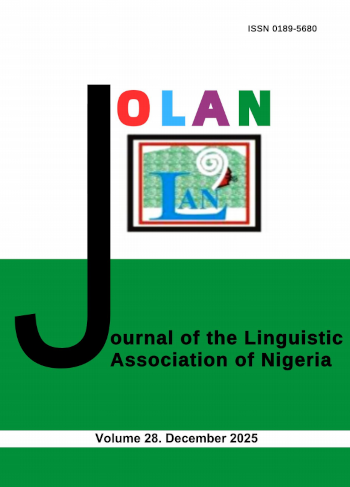Nnyocha mmebemusoro aha ebe n’ Owerre-Ezukala Igbo
Keywords:
aha ebe, onomastiks, mmebemusoro, mọfịm mfe, aha ebe nha, mgbakwunye ụtọ, asụsụ, myịabụọ,, Toponymy, onomastics, morphosyntatic, single root morphemes, compound toponymsAbstract
Igbo
Nchọcha a lebara anya n’aha ebe n’olu ndị Owerre-Ezukala Igbo site n’ịgbado ụkwụ na mmebemusoro. O nyochara aha ebe n’olu ndị Owerre-Ezukala iji kpebite na nghọta aha ebe n’asụsụ na-esite na mmetụta mmebe okwu, usoro okwu na echiche n’ebe ọ dị ukwuu. Atụmatụ ọnọmastik metụtara ọmụmụ aha aka na aha ebe. Ụfọdụ aha ebe n’olu ndị Owerre-Ezukala Igbo na-esite n’usoro a haziri ahazi iji chekwaa nghọta ya. Nchọcha ji atụmatụ nkenụdị aha ebe Tent & Blair rụọ ọrụ iji nyochaa ndokọ mmebe okwu na usoro okwu ụfọdụ aha ebe. E ji usoro sampụl tụmbọm tụmbọm wee nweta data site n’ajụjụ ọnụ. Dị ka okwe si gbaa, a chọpụtara na ntụcha mmebe okwu ụfọdụ aha ebe n’olu ndị Owerre-Ezukala Igbo nwere ike ịbụ otu mọfịm dị ka ‘ozu’ (ugbo/ubi), ama dị ka ‘Ishiahọ’ (isi ahịa), mgbakwunye ụtọ asụsụ dị ka ‘Ụmụndam’ na myịabụọ dị ka ‘Ishishi’ (onye kachasị mee okenye). Nchọcha chọpụtakwara na ụfọdụ aha ebe dị ka Obunagụ, Ọgbanelu, Ụmụerum, n’ogo ahịrị okwu nwere ike ịrụ ọrụ dị ka ahịrị nkwusa, ajụjụ na ntimiwu. Ọrụ a kwadoro atụmatụ nke kwuru na e nwere ike ịgbaso usoro mmebemusoro mụọ aha iji gosi aha ebe, akụkọ gbasara ha na ntụcha kelingwistiiks.
English
The paper studies toponyms in Owerre-Ezukala lect of Igbo from a morphosyntatic perspective. It examine place names in Owerre-Ezukala lect of Igbo to establish the facts that some toponyms are given in a particular language whose morphology, syntax and semantics inform their meaning to a great extent. Given that Onomastic framework involves the study of personal names and place names. Some toponyms in Owerre-Ezukala lect of Igbo are formed through systematic processes to preserve their meaning. The paper adopts the theoretical framework of Tent and Blair’s toponymic typology to examine the morphological and syntactic structures of some place names. Random sampling technique is employed to gather data through interviews. The results reveal that morphological analysis of some place names in Owerre-Ezukala lect of Igbo can be single root morpheme like ’ozu’ (farmstead), compound like’Ishiaho’(head of the market), inflection like ‘Umundam’(children of Ndam), and reduplication like’Ishishi’(eldest). The study also ascertains that some place names such as ‘Obunagu’,’Ogabanelu’,’Umuerum’ at the sentential level can function as statements, interrogatives, and imperatives. The work supports the theory that names can be studied through morphosyntatic perspective to show place names, their history and linguistic analysis.
References
Agbo, M.S. (2014). Causativity in Igbo personal names. Journal of universal language 15 (2),1-33.
Baker, R. & Carmony, M. (1975). Indiana place names. Bloomington; Indian University Press.
Cano, L.R. (2008). Toponymic analysis of lienzos. Mixtechlowlands: Oaxaca.
Cresswell, T. (2004). Place: a short introduction. Melbourne: Blackwell.
Ekejiuba, G. U. (1995). Suprasegmental of Owerre-Ezukala dialect of Igbo and English: A constrastive analysis. BA project. University ofNigeria, Nsukka.
Glaser, R. (1998). Australian toponym in the light of socio-onomastics. Nicolaisen, W.F.H.(ed) Scope, perspectives and methods of Onomastis, 2. Aberdeen: University of Aberdeen133-140.
Iwudu, M.C. (1994). Name and naming: a theoretical overview. The muse: literary Journal of the English association at Nsukka. (24), Enugu: Magnet Sunrise.
Klugah, M.A. (2013). Recounting history through linguistics: A toponymic analysis of Asogli migration narratives. African journal of history and culture 5, 151 – 159
Maduagwu, G.O. (2009). Igbo personal names: A morpho-semantic study language matters. Studies in the languages of African, 41(2), 315-324.
Okoye, C.L. (2013). Igbo and Chinese personal names: A socio-semantic analysis. Ph.D Seminar Paper, Department of Linguistics, Igbo & Other Nigerian Languages, Univeersity of Nigeria, Nsukka
Owu-Ewie, C.(2014), A morphosyntactic analysis of some Fante habitation names (econym). International journal of humanities and social studies 2, 232-243.
Radding, L. & Western, J. (2010). What’s in a name? Linguistics, geography and toponyms. Geographical review, American geographical society. New York. 394-412
Smith, G. (1996). American place name: a typology based on naming and form. Onomastica Canadiana 78, 53-54.
Spencer, A. (1991). Morphological theory. Oxford: Basil Blackwell.
Stewart, G.R. (1975). Names on the globe. New York: Oxford University Press.
Tent, J. & Slatyer, H. (2009). Naming places on the sotuh land: European place – naming Practices from 1606 to 1803. Australian historical studies. 40; (1):5-31.
Tent, T. & Blair, D. (2011). Motivations in naming the development of a toponymic typology for Australian place names. Names 59: 67-87.
Udoye, I. & Ofoegbu, C. (2011). A morphological analysis of Awka personal names. Journal of arts and contemporary studies, 3: 85-89.














